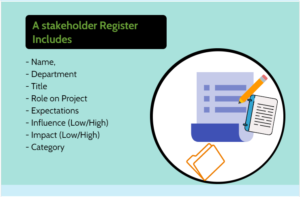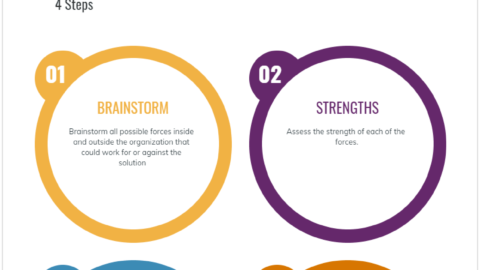Stakeholder Register in Project Management
What is the importance of having a proper stakeholder register in place for project management? Stakeholder management is one of the most important processes in any project’s life cycle. It is a type of strategic management process that smart project managers follow to get support for their projects from others, both internal and external. Stakeholders can be an individual, an organization, a community, a group of people, an investor that can affect or be affected by the outcomes of a project, or an organization. They may have positive or negative impacts and they may be either internal or external to the organization. A Stakeholder register is created to document who is impacted by the project and who have an influence and impact on the project. It contains information to deal with project stakeholders who have different levels of interests and impacts on the project’s objectives. In this article, we will discuss the importance of stakeholder management and provide a stakeholder register template example to help you to manage your project’s stakeholders effectively.
Table of Contents
Importance of Stakeholder Management in the Success of a Project

Stakeholders can be positive, negative, internal, or external to the project or the organization. Department heads, project coordinators, project team members, executive managers, the board of directors, and project sponsors are the example for internal stakeholders whose operations affect or be affected by the project.
External stakeholders are those who are external to the project’s organization. Vendors, suppliers, regulatory bodies, government, communities, and organizations are examples of external stakeholders.
Stakeholder satisfaction is a key success criterion for any type of project. No matter if you’re managing a sophisticated IT project or a small office construction project, you have to fulfill your stakeholder’s requirements. For successful project managers, it is a good practice to fully engage all positive stakeholders using effective communication tools and techniques based on a strategy in order to gain their support.
Stakeholder management is a repetitious process that is performed through the life cycle of a project. Although there are many tools and techniques available for the development of a stakeholder strategy, stakeholder management is a unique process to the project. Therefore it should be tailored considering the characteristics of the project.
Identification of key project stakeholders process comes just after the signage of the project charter. After that, you need to document the stakeholder information in a register. In other words, you will create the stakeholder register once the project charter is signed.
When Do We Start the Stakeholder Analysis?
One of the first things that a project manager should do is to start identifying stakeholders at the beginning of a project. Everything related to stakeholder management starts with asking those simple but effective questions;
- Who may be impacted by the outcomes of the project?
- Who may impact the project objectives?
This will set a starting point for your stakeholder management process.
Stakeholder Management
Before talking about the stakeholder register template, it is essential to have a look at stakeholder identification and evaluation.
Identification

It is quite easy to identify some stakeholders – project manager, project team, client, the board of directors, investors, etc. On the other hand, some stakeholders that have potential impacts, can not be detected easily. Analyzing the stakeholder registers of past projects increases your chance to understand how they interact with the project.
Below tips can be helpful;
- Work with your sponsor to identify the ones at the primary levels.
- Brainstorm with your project team to identify individuals and groups
- Request experts knowledge
- Analyze the registers of past and similar projects.
Evaluation
Different types of stakeholders may have different impacts on your project objectives. Their impact level is not the same. If you want to use your time and resources effectively while managing stakeholders, you have to classify them according to their power and interests. Stakeholders can be evaluated according to the following factors:
- Requirements
- Communication Needs
- Expectations
- Influence
- Interest
- Power
Stakeholder Register Template
The Stakeholder register is one of the most important project documents that helps to classify, identify, and assess the stakeholders of the project. The stakeholder register answers many questions regarding the stakeholders. Following are some of them;
- What are the names and contact details of the stakeholders?
- What are the expectations and requirements of the stakeholders?
- Who are the most critical stakeholders?
- What are the communication methods to deal with stakeholders?
- What is the impact level of stakeholders?
Basically, a stakeholder register is created in the early phases right after the project charter is signed. Stakeholder identification is the first step of creating a stakeholder register. Stakeholders can be identified by reviewing past and similar projects records, brainstorming with the project team, meeting with the project sponsor, and exploring the vendors involved in the project
After the stakeholder identification, stakeholder analysis, classification, and management processes comes.
The PMBOK Guide recommends the tools below for stakeholder classification;
1. Power/interest grid
2. Power/influence grid
3. Influence/impact grid
4. Salience model
Stakeholders are classified according to their power, influence, impact, and interest on a project. Also, they can be classified according to their urgency, and legitimacy.

Stakeholder Register Example
Typically, a stakeholder register includes the information below;
– Name,
– Department
– Title
– Role on Project
– Expectations
– Influence (Low/High)
– Impact (Low/High)
– Category
A stakeholder register includes columns that address specific questions. It can be customized considering the project requirements. The below figure outlines an example of the stakeholder register.
Note that the stakeholder register is a living document that should be kept updated during the project’s life cycle. It provides information about all key project stakeholders and their attributes.
Stakeholder registers are important project management documents that should be kept updated throughout the project life cycle. It is a living document that helps the project team to index all project stakeholders. As the project progresses, stakeholders and their influences on the project changes. New stakeholders come to existence and some stakeholders lose their attention on the project. Also their power and impact on the project changes. In addition to that, the stakeholder register must be a confidential document because it includes so much information about different people and organizations.
For successful project management, the importance of a stakeholder register can never be denied.
Benefits of Stakeholder Register
As a project manager, you should be aware of that fact: Stakeholders can make everything either difficult or easy. And everything tends to change in a project because projects are dynamic in nature. An individual or group may be interested in your project at first but may lose interest over time. Or maybe a group doesn’t want you to realize a project that you have undertaken.
How can we manage all these factors? The answer is easy: use the stakeholder to come up with. While managing a project, classifying, identifying, and assessing stakeholder requirements studies can save you. Creating a register is easy, it is just writing something on a computer screen. Having a complete register helps to manage our limited time successfully while dealing with a number of issues in projects.
Summary
Stakeholder management plays a key role in the success of a project. Mismanagement of project stakeholders who have high power and interest may contribute to the project’s failure. Therefore project teams must perform timely and careful stakeholder analysis, classification, and prioritization considering the stakeholder’s abilities to affect the project.
It is a good practice to create the register as early as possible. There are various examples and templates available on the internet. You can download them, customize them for your project’s requirements, add columns if needed, and use them for your project to index the stakeholder information. The proposed template in this article, which shows how the stakeholder register could look like, is also useful for you.
In this article, we discuss the importance of stakeholder management and provide a stakeholder register template example. Note that this is an important topic that should be known from the PMP Certification Exam point of view. You can add or share anything you want by using the comments box below.
See Also
External References

Wanda is the Director of Blue Horizons Professional Training Services which focuses on the delivery of PMI-SP, Stakeholder Management and other project related workshops, training, mentoring and consulting services. She holds a Doctor of Project Management from Harward University.











I reckon something genuinely special in this site.
Thanks for finally writing about >Stakeholder Register in Project Management – projectcubicle <Loved it!